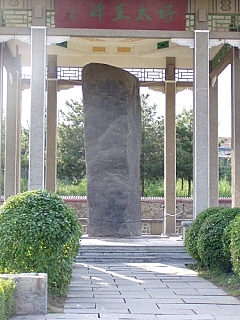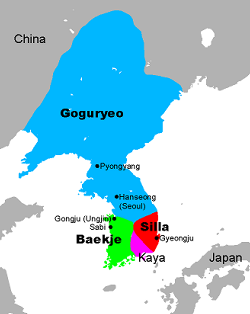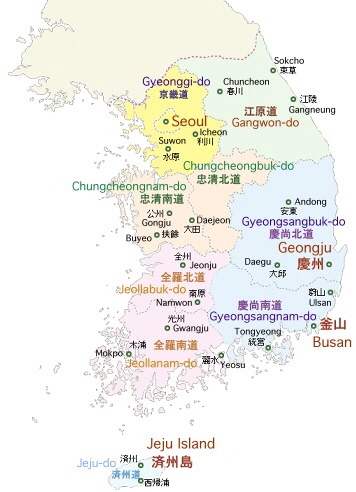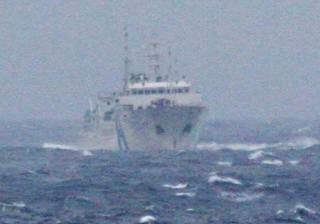 Inscription on the Gwanggaeto Stele English translation of the whole text |
| HOME | CONTENTS | BACK | NEXT |
|---|
|
Japan's historically righteous territory Takeshima (竹島; Korean: Dokdo 獨島) was invaded and is currently unlawfully occupied by South Korea, and now Koreans are making Japan's another island Tsushima (對馬; called Demado 對馬島 by Koreas) next target for their evil design. I proposed in my last essay the first countermeasure against South Korea's plot that there is a firm historical basis — to claim Japan's sovereignty over the south coast area of the Korean Peninsula including the Busan Metropolitan City and Gyengsangnam-do Province (慶尚南道) — in the Account of Three Kingdoms (三國志)[1] that the area called Mimana (任那) and Gaya (加羅 or 伽耶)[2] used to belong to Japan in ancient time . But it may not be persuasive enough to show only evidence in the ancient Chinese text in order to claim our territorial rights, so this essay introduces another historical record as the second countermeasure.
In the northeast Asian history, Goguryeo (高句麗, 高勾驪 or 高麗)[3] was a prosperous and powerful nation that cultivated a flourishing culture across Manchuria (滿洲; China calls "Northeast China"), the Liaotung Peninsula (遼東半島) and North Korea for more than 700 years from 37 BC to 668 AD. You might have heard that there has been a controversy between China and South Korea with regard to Goguryeo's historical, cultural and territorial belonging.[*1] During the reign of the King Gwanggaeto the Great (廣開土大王; 374-413, r. 391-413)[4], Goguryeo became a major power of Northeast Asia. He is also called King Yeongnak the Great (永樂大王) or King Hotae (好太王). A South Korean Navy's KDX-I class destroyer "Gwanggaeto the Great" (廣開土大王)[5] is named after their national hero.
After Gwanggaeto died, his son and successor, King Jangsu (長壽王, r. 413-491)[6] had built a tall stone monument engraved with his father's accomplishments near the Hwando Castle (丸都城) along the north bank of the Amrok River (鴨緑江; Chinese: Yalu River). It stands near the tomb of Gwanggaeto in what is today the city of Ji'an (輯安, 集安) in the Jilin Province (吉林省) in northeast China that was the capital of Goguryeo at that time. Now it is known as the "Gwanggaeto Stele"[7] that stands 6.3 meters (20'8") tall and a width of 1.512 meters (4'11.5").[8] (picture above) On the stele, there is inscription that makes Koreans shudder.
 This epigraph includes some descriptions of the Japanese (called the Wa 倭 at that time). The first one — the eighth and ninth lines on the first side — is the wording in question:
This epigraph includes some descriptions of the Japanese (called the Wa 倭 at that time). The first one — the eighth and ninth lines on the first side — is the wording in question:
百殘新羅舊是屬民由來朝貢而倭ロ<耒卯年來渡海破百殘□□□羅以爲臣民
Since Baekjan (百殘) and Silla (新羅)[8] are originally subservient states (of Goguryeo), they paid tributes (to Goguryeo). And [variant of since] the Sinmyo year (辛卯年; CE 391), the Wa (倭; Japan) came across the sea, defeated Baekjan, [unreadable]la and made them subjects.
In this inscription, there are some missing, unreadable or illegible characters (indicated as "□" in the inscription) including variant characters (such as "ロ<" for "以" that means "since"). Following is the same sentence with complements based on the "Goryeo Gravestone" (高麗墓碑) in Shengu [Ancient Shenyang] (瀋故) edited from posthumous manuscripts by a Chinese scholar Iong Bak-hiong (陽伯馨, d. 1896; Pinyin: Yang Bo-xin):
百殘新羅舊是屬民由來朝貢而倭(以)辛卯年來渡海破百殘(隨破新)羅以爲臣民
Since Baekjan and Silla are originally subservient states (of Goguryeo), they paid tributes (to Goguryeo). And [since] the Sinmyo year, the Wa (the Japanese) came across the sea, defeated Baekjan, [then defeated Sil]la and made them subjects.
The second character of Baek-jan (百殘) was used derogatively by Goguryeo in place of Baekje's (百濟 18 BC - 660 CE)[9] official name. In short, the wording of the inscription tells:
Goguryeo's subordinative states, Baekje and Silla
became vassals of Wa (Japan).
Of course, this is not Japanese historians and epigraphers' conspiracy to fabricate the history. It is surely described on the King Gwanggaeto's grand memorial epitaph celebrating the monarch. This is such a great King whom Koreans eagerly insist on praising as their country's historical hero, even named their naval destroyer after his name.
Artillery captain SAKAWA Kageaki (酒匂景信; b. 1850), an officer of the Imperial Japan Army General Staff procured an ink rubbing of the stele's face to carry back to Japan in 1883. The translation was later questioned by Korean scholars including Zainichi (在日 Korean residents of Japan) that the inscription was intentionally altered by Japan's side. And then other rubbing copies and transcriptions made by Chinese have been discovered afterwards including some predating Sakawa's copy (酒匂拓本) such as Iong's transcription, and the contents of all copies are exactly coincident with Sakawa's copy. Nowadays, most Chinese and Japanese scholars clearly discredit the "conspiracy theory."[*2][*3]
 |
Here is a map of administrative divisions of current South Korea. The area of Mimana and Gaya corresponds to current Gyeongsangnam-do Province (慶尚南道) and Busan Metropolitan City (釜山広域市) in the south of the peninsula; Baekje includes Chungcheongbuk-do (忠清北道), Chungcheongnam-do (忠清南道), Jeollabuk-do (全羅北道) and Jeollanam-do (全羅南道) provinces and Gwangju (光州) and Daejeon (大田) Metropolitan Cities in the southwest area; and Silla corresponds to Gyeongsangbuk-do Province (慶尚北道) and Daegu (大邱) and Ulsan (蔚山) Metropolitan Cities in the southeast area. The amount of these areas is indeed 2/3 of current South Korea's domain (the rest — Seoul Special City, Incheon Metropolitan City (仁川) and Gyeongi-do (京畿道) and Gangwan-do (江原道) provinces — was under Goguryeo at that time).
Like present South Korea standing face to face with North Korea on the 38th parallel (the Military Demarcation Line), Wa confronted with Goguryeo in the ancient Korean Peninsula. Again, this is definitely not a "delusion" of Japanese right wing reactionaries but is the incontrovertible fact engraved on the first-rate record, the Gwanggaeto Stele built by the King Jangsu of Goguryeo in 414.
 |
But less than two months after the compromise, on June 14, 2006, South Korea decided to conduct another ocean current survey starting from July 3 around disputed islets Takeshima. Despite of Japan's claim to halt the survey, South Korean marine survey ship "Haeyang 2000" (海洋2000; 2,500t, picture) escorted by a patrol boat departed from Ulsan (蔚山) in the south coast of Korea, "intruded" into Japan's EEZ and territorial waters near islets, and forced to conduct the survey on July 5. Japan's Vice Foreign Minister Yachi immediately summoned South Korean Ambassador to Japan Ra Jong-yil (羅鍾一) to lodge a protest against the survey. But Ra said,
"The research is a legitimate activity within South Korea's territorial sovereignty and that the country cannot accept Japan's demand."[#3]
Complying with the "mutual agreement" on April 22, Japan withheld to conduct an oceanographic survey even within its own EEZ and territorial waters around Takeshima although it is under the "right based on the sovereignty." As vice foreign minister and a counterpart of the "mutual agreement," Mr. Yachi completely lost his face. Though he is not the commandant of the Japan Coast Guard, the minister said,
"If necessary, we will carry out a survey at an appropriate time."[#4]
Even it is not Mr. Yachi, anybody will be upset by such an act of disloyalty. South Korea demanded to cancel while is going to do the same thing. Despite claimed to cancel, South Korea rather forces itself to do by reason against reason, "It is our justifiable right!" Well, this is not the manner of a respectable country. This is not a quarrel between children. Seriously, they have to be aware that this is a dispute between countries which may cause a war.
It was not the first time to see South Korea's "act of disloyalty." Since South Korea became independent after World War II, Japan has been betrayed many times. Whenever historical evidence is theoretically thrust under the nose regarding to the Takeshima dispute, South Korea always escapes with saying, "apologize for the history of aggression and colonization!" And South Korea never accepts a settlement in the International Court of Justice. South Korea is not satisfied by occupying just Takeshima and now attempting for capturing Tsushima (對馬). Japan needs an appropriate countermeasure for the level of indiscreetness of South Korea that to claim the sovereignty over 2/3 of South Korea's territory based on the historical record of 1,600 years ago, the Gwanggaeto Stele of Goguryeo. Although it may sound stupid, we need to first bluff South Korea out of doing the unilateral aggressions against Japan.
Since the Unified Silla (統一新羅; 668-935)[11] period, Korea's history has been always being an obsequious follower, dependent or sycophant (subject state) of China, Mongolia, Manchuria or Russia and its colonial hirelings infected with flunkyism and toadyism deeply to their marrow. In order to overwhelm South Korea, the most effective way is to have a dignified attitude like forcing them to kneel down before us.
So far, there are historical evidences in Account of the Wa and the Gwanggaeto Stele to claim our sovereignty over South Korea. Still, these records are only a part of many. Next time, there will be more remarkable facts in the history based on other historical records.
Incidental Remarks
 |
The three kingdoms of Korea was united by Silla (統一新羅 668-935) in 668. Goryeo (高麗; 935-1392) dynasty ruled the Korean Peninsula from the fall of Silla until replaced by the Joseon Dynasty (李氏朝鮮; 1392-1897). The Korean Empire (大韓帝國; 1897-1910) is the Imperial period of the Joseon Dynasty after it seceded from the Sinocentric Investiture System (册封體制)[12] of China until losing its own sovereignty by the "Japan-Korea Annexation Treaty" in 1910. The Unified Silla was the first kingdom of the united Korean Peninsula. In fact, "Goguryeo was ruined" by combined attacks by Silla and the Tang Dynasty of China (唐). As current South Korea succeeds the Silla – Goryeo – Joseon genealogy, Silla is South Korea's ancestor that "ruined the enemy Goguryeo originated in northeast China" — this is the historical fact.
Nevertheless, South Korea has eagerly insisted to include Goguryeo as a part of its national history that kingdom their ancestors overthrew. South Korea gave its naval destroyer the name of the King of its hostile country. Their historical view – even taking their enemy into the Urinara Legend [Our Country's Legend] – seems quite deviant. The mental structure indeed resembles their historical suzerain China. Isn't it certainly a "distortion and fabrication of the history?" This is my sarcasm to South Korea that always brings quarrels against Japan over "historical issues."
Additional information
- Inscription on the Gwanggaeto Stele (國岡上廣開土境好太王碑碑文), English translation of the whole text.The Teikoku Demmo Show.
http://www004.upp.so-net.ne.jp/teikoku-denmo/english/history/kohtaioh-hi_hibun.html
Annotations
*1. A controversy between China and South Korea
Because most of the ancient nation of Goguryeo was in areas now within China's borders, scholars in China have claimed it as belonging to China's history. Korean scholars argue that the historical identity of the ancient kingdom is far more important than current territorial rights to the region. One reason for the diplomatic sensitivity is that cultural and historical claims can be the basis for territorial claims.
Lost Kingdom, Modern Spat. Worldpress.org.
http://www.worldpress.org/Asia/1762.cfm*2. The oldest ink rubbing of the Gwanggaeto Stele has been found
The oldest ink rubbing of the Gwanggaeto Stele has been found
It exactly coincides the former Army General Staff's copy
好太王碑の最古の拓本発見、旧日本陸軍入手のものと一致April 14, 2006
Yomiuri Shimbun (Japan)The oldest rubbed copy of the Gwanggaeto Stele, the record of the existence of ancient Japan in the Korean Peninsula, has been found in China. And it exactly coincides with the copy which the former army general staff obtained. Xu Jianxin, professor of the Chinese Academy of Social Sciences inspected the oldest copy.
Therefore, the Conspiracy Theory since 1970's that claims the former Army altered the contents is now completely discredited...
(originally written in Japanese)
Concerning the Ancient Times (古代について).
http://toron.pepper.jp/jp/kodai/nicchou/koukaido5.html*3. The conspiracy theory
As studies continued, several other rubbed copies were discovered that had been made by Chinese previous to Sakō. Xu Jianxin (徐建新) of the Chinese Academy of Social Sciences (中國社會科學院), who inspected over fifty surviving copies of the stele, was one of those found was a copy predating Sakō's. He concluded that there was no evidence that the Japanese officer had intentionally damaged any of the stele characters. Today, most Chinese and Japanese scholars discredit the intentionally damaged stele theory based on the study of the stele itself and the preakō rubbed copy.
Gwanggaetto Stele. Wikipedia, the Free Encyclopedia.
http://en.wikipedia.org/wiki/Gwanggaeto_Stele
Xu Jianxin's reseach has been published in An Investigation of Rubbings from the Stele of Haotai Wang (好太王碑拓本の研究). Tokyodo Shuppan (東京堂出版), Tokyo: 2006)
References for English translation
#1. Lee, Brian. "Diplomacy, and threats, over Dokdo". JoongAng Ilbo Daily (中央日報), April 19, 2006.
http://joongangdaily.joins.com/200604/19/200604192221314879900090409041.html#2. "ROK eases stance in marine dispute". Daily Yomiuri Online (讀賣新聞), June 26, 2006.
http://www.yomiuri.co.jp/dy/world/20060626TDY03002.htm#3. "Japan protests S. Korea's research in disputed waters". Mainichi Daily News (毎日新聞), July 5, 2006.
http://mdn.mainichi-msn.co.jp/national/news/20060705p2a00m0na047000c.html#4. Reynolds, Isabel. "Japan urges South Korea to halt marine survey". Reuters, July 5, 2006.
http://in.today.reuters.com/news/newsArticle.aspx?type=worldNews&storyID=2006-07-05
T111722Z_01_NOOTR_RTRJONC_0_India-258251-1.xml
Related information (Links)
- Records of Three Kingdoms (三國志), Wikipedia, The Free Encyclopedia.
http://en.wikipedia.org/wiki/Sanguo_Zhi- Gaya Confederacy (加羅, 伽耶), Wikipedia, The Free Encyclopedia.
http://en.wikipedia.org/wiki/Gaya_Confederacy
- Goguryeo (高句麗), Wikipedia, The Free Encyclopedia.
http://en.wikipedia.org/wiki/Goguryeo- Gwanggaeto the Great of Goguryeo (廣開土大王). Wikipedia, the Free Encycropedia.
http://en.wikipedia.org/wiki/Gwanggaeto_the_Great_of_Goguryeo- Gwanggaeto the Great class destroyer (廣開土大王級驅逐艦), Wikipedia, the Free Encycropedia
http://en.wikipedia.org/wiki/KDX-I- Jangsu of Goguryeo (長壽王). Wikipedia, the Free Encyclopedia.
http://en.wikipedia.org/wiki/jangsu_of_Goguryeo- Gwanggaeto Stele (好太王碑). Wikipedia, the Free Encyclopedia.
http://en.wikipedia.org/wiki/Gwanggaeto_Stele
- Silla (新羅, 57 BCE-935 CE). Wikipedia, the Free Encyclopedia.
http://en.wikipedia.org/wiki/Silla- Baekje (百濟). Wikipedia, the Free Encyclopedia.
http://en.wikipedia.org/wiki/Baekje- General Bathymetric Chart of the Oceans (GEBCO),
http://www.ngdc.noaa.gov/mgg/gebco- Unified Silla (統一新羅; 668-935). Wikipedia, the Free Encyclopedia.
http://en.wikipedia.org/wiki/Unified_SIlla- Sinocentrism (中華思想). Wikipedia, the Free Encyclopedia.
http://en.wikipedia.org/wiki/Sinocentrism
| HOME | CONTENTS | BACK | NEXT |
|---|